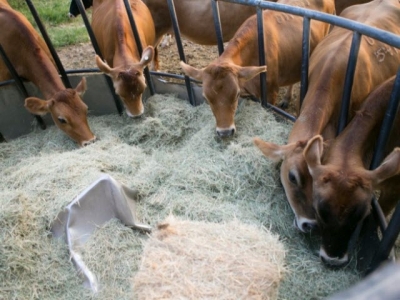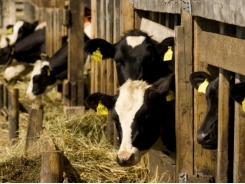Lipid, starch combo may boost feed efficacy and cut gas in cattle

Adding ground soybeans and starch to cattle diets may improve feed efficiency and limit methane emissions, say researchers.
A group of Brazilian researchers examined the use of ground soybeans and starch on aspects of cattle production including feed intake, digestion, performance and methane generation. The team published their results in the journal of Animal Feed Science and Technology.
“The aim of this study was, thus, to evaluate the effect of including soybean combined with either a high or a low level of starch in the finishing of feedlot young Nellore bulls on their intake and digestibility, weight gain, carcass characteristics, and methane production,” the researchers said.
The researchers found that their hypothesis was corroborated by some combinations of the starch and lipids mix added to the cattle diets, they said.
“The inclusion of approximately 250 g of soybean/kg DM [dry matter] in the diet of feedlot young Nellore bulls results in an increase in feed efficiency and reduces enteric CH4 emission, regardless of the level of starch in the concentrate, without affecting carcass characteristics,” concluded the authors.
Why a lipid and starch combo?
Methane production by ruminants is considered to be the main greenhouse gas generated at the farm level, said the researchers. In addition to being an environmental concern, gas production is an energy loss ranging from 2 to 12% of gross energy intake for the animal.
Reducing enteric methane generation should reduce the inefficiency and improve the environmental side of ruminant production, they said.
One method to address methane production is to add lipids to the diet as they can improve energy efficiency and reduce methanogenesis, they said. Adding soybeans also reduces ruminal protozoa, which limit the substrate needed for methane production.
“Of the various lipid sources available for ruminant nutrition in Brazil, soybean is valued for its wide availability, low cost, and high nutritive content,” said the researchers. “Brazil is currently the world’s largest soybean producer.”
A second way to reduce methane production is through the use of fermentable starch in cattle feed, they said. This feed ingredient may increase propionate production and limit methane, but adding starch also can reduce ruminal digestibility of neutral detergent fiber (NDF).
“This reduction can be partially explained by negative effects of higher starch intake on the ruminal bacterial populations,” they said. “Soybean hulls provide an alternative energy source that represents a highly digestible fibrous ingredient with minimal effects on fiber degradation.”
However, little work has examined the use of both dietary starch and lipids on animal performance and methane production, said the researchers. “We hypothesized that replacing corn with soybean hulls as an energy source, combined with ground soybean as a lipid source, may reduce methane emissions without affecting the performance or carcass characteristics of feedlot beef cattle,” they added.
Methods
In the feeding study, a group of 28 cattle were given one of four trial diets for 119 days, said the researchers. The diets included either high starch (HS) at 250 g/kg or low starch (LS) at 110 g/kg and with (WSB) or without (NSB) ground soybeans.
“Ground soybean was added as a lipid source to diets HS-WSB, LS-WSB, HS-NSB, and LS-NSB, representing 58.7, 64.6, 24.8, and 31.4 g/kg ether extract in the total dry matter, respectively,” they said.
Total weight gain, average daily gain were calculated for the entirety of the trial, and they were weighed every 30 days, they said. Fecal samples were collected to check for digestibility.
Gas production was measured with collection halters for five days at the end of the trial, said the researchers.
Results
Cattle getting the trial diets that included soybeans had about an 11% reduction in their intake for dry matter, organic matter (OM) and crude protein, said the researchers. The addition also decreased apparent digestibility of dry matter by 3% and the digestibility of organic matter by about 2.8%.
They also found an association between starch and soybean inclusion on neutral detergent fiber intake, they said. “A significant interaction was detected between starch and soybean on the apparent digestibility of ether extract and neutral detergent fiber; the lowest values for ether extract (750 g/kg) and neutral detergent fiber (432 g/kg) were obtained with HS-WSB,” they added.
However, cattle that received the WSB diet saw a 17% improvement in feed efficiency, said the researchers. “The enteric CH4 emissions of the animals fed WSB reduced significantly (P = 0.01), with 28% decrease in g CH4/d and g CH4/y, 16% decrease in g CH4 per kg of dry matter intake, and 23% decrease in CH4 losses per percent of gross energy intake,” they added.
Related news
Tools

Phối trộn thức ăn chăn nuôi

Pha dung dịch thủy canh

Định mức cho tôm ăn

Phối trộn phân bón NPK

Xác định tỷ lệ tôm sống

Chuyển đổi đơn vị phân bón

Xác định công suất sục khí

Chuyển đổi đơn vị tôm

Tính diện tích nhà kính

Tính thể tích ao



 Tannins in feed may offer production boost for…
Tannins in feed may offer production boost for…  New smart sensor to help farmers spot lameness…
New smart sensor to help farmers spot lameness…